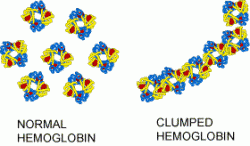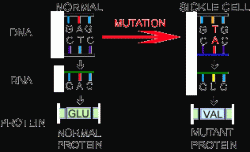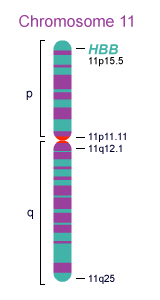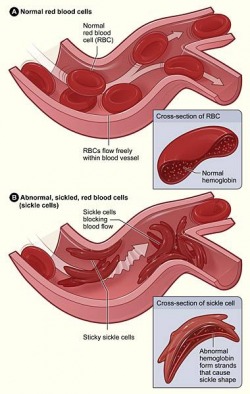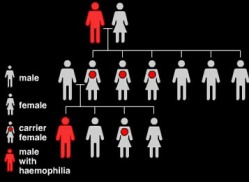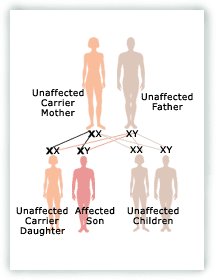SICKLE CELL ANEMIA INTRO.
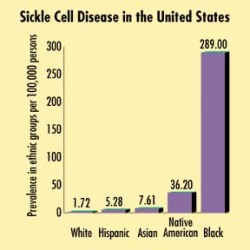
When you have the sickle cell anemia the red blood cells are sickle-shaped. There are many symptoms for this disease a few include: fatigue, breathlessness,jaundice,paleness,susceptibility to infections, hand and foot swelling,painful joints, hands, arms, legs, and back and chest syndrome. Most patients with this disease live a short live span. Males live up to 42 years of age while females live up to 48 years. Basically what sickle cell anemia is blood disorder that gives you lots of pain. The sickle blood cells die quite fast. Normal red blood cells live for 120 days but the sickle-celled ones live for 10-20 days. The cells cannot be replaced fast and that is why the blood is short of red blood cells. There are no known cures for this disease but there are a few treatments to help patients. Some of these include: Blood transfusions, oral antibiotics, and hydroxyurea. The chromosome that is affected is chromosome 11. The name of the gene product is hemoglobin.
EFFECTS OF PROTEIN LEVEL EFFECTS OF DNA LEVEL
HAEMOPHILIA
HAEMOPHILIA
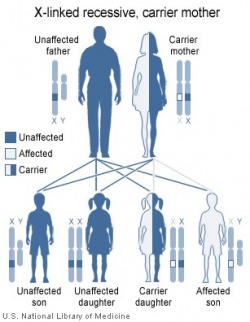
- Haemophilia is a group of innate genetic disorders that injure the body's ability to control blood from thickening or clotting (which is used to stop bleeding when a blood vessel is broken). Haemophilia A is the most common form of disorder for males. It occurs at about 1 in 5000-10000 male births. Haemophilia B occurs at about 1 in about 20000 up to 34000 male births(most other recessive sex linked, X chromosome disorders only males exhibit symptoms). This happens because females have two X chromosomes, and males only have one. Since females have two X chromosomes, and because haemophilia is rare, the chances of a female having two defective copies of the gene is very low. So females are almost incompatible to this disorder. Female carriers could inherit the defective gene from their mother, father, or it could be a new mutation. Only under very rare circumstances do females actually have haemophilia. Haemophilia lowers blood plasma clotting factor levels of the coagulation factors needed for a normal clotting process. When a blood vessel is injured (a temporary scab forms) but the missing coagulation factors prevent fibrin formation (which is necessary to maintain the blood cot). Because of that haemophiliac does not bleed more intensely than a normal person, but it can bleed for a much longer amount of time. In severe haemophiliacs even a minor injury can result in blood loss lasting days, weeks, or it may not even stop! In places like the brain or inside joints, it can be fatal or permanently weakening. Haemophilia A is a recessive X-linked genetic disorder involving a lack of functional clotting factor VIII and represents 90% of hemophilia cases. Haemophilia B is a recessive X-linked genetic disorder involving a lack of functional clotting factor IX. It is similar to but less common than hemophilia A. Haemophilia C is anautosomal genetic disorder (not X-linked) that involves a lack of functional clotting factor XI. There are a lot different mutations which cause each type of hemophilia.Patients with hemophilia often have some level of active clotting factor (due to differences in changes to the genes involved).
Individuals with less than 1% active factors are classified as having severe haemophilia. Those with 1-5% active factor have moderate haemophilia, and those with mild haemophilia have between 5-40% of normal levels of active clotting factor.Though there is no cure for haemophilia, it can be treated with regular infusions of the deficient clotting factor: Factor VIII in haemophilia A or factor XI in haemophilia B. Factor replacement can be either taken from human blood serum, recombinant, or both of them. It is recommended that people affected with haemophilia do specific exercises to strengthen joints. Mostly the elbows, knees, and ankles. Exercises which increase flexibility, tone, and strength of muscles is increasing their ability to protect joints from damaging bleeds. These exercises are recommended after an internal bleed occurs and as a daily basis to strengthen the muscles and joints to prevent new bleeding problems. Some exercises you can use to strengthen muscles are: Normal sports, warm-ups and exercises such as stretching your calves, ankle circles, flexing elbows, and quadriceps .Haemophilia is rare. Each year in the US, about 400 babies are born with the disorder. Haemophilia usually occurs in males and less often in females. Scientists estimated that about 2500 Canadians have haemophilia A, and about 500 Canadians have haemophilia B. The symptoms are bleeds, but they are severe bleeds.
Bibliography
Works Cited
"A case study of the effects of mutation: Sickle cell anemia." Understanding Evolution. N.p., n.d. Web. 24 Nov. 2009. <http://evolution.berkeley.edu/evolibrary/article/mutations_06>.
"Haemophilia - Wikipedia, the free encyclopedia." Wikipedia, the free encyclopedia. N.p., n.d. Web. 24 Nov. 2009. <http://en.wikipedia.org/wiki/Haemophilia>.
"Haemophilia Diagnosis, Causes, Symptoms & Treatment." Health & Lifestyle Portal. Home Remedies, Pregnancy, Relationships, Health Care, Diet, Q&A, Shopping, Baby Care, Vitamins. N.p., n.d. Web. 24 Nov. 2009. <http://www.ayushveda.com/healthcare/haemophilia.htm>.
"Sickle Cell Anemia Disease Profile." Oak Ridge National Laboratory. N.p., n.d. Web. 24 Nov. 2009. <http://www.ornl.gov/sci/techresources/Human_Genome/posters/chromosome/sca.shtml>.
"Sickle Cell Anemia Gene." Oak Ridge National Laboratory. N.p., n.d. Web. 24 Nov. 2009. <http://www.ornl.gov/sci/techresources/Human_Genome/posters/chromosome/hbb.shtml>.
"Sickle Cell Anemia, Signs and Symptoms ." National Heart, Lung and Blood Institute. N.p., n.d. Web. 24 Nov. 2009. <http://www.nhlbi.nih.gov/health/dci/Diseases/Sca/SCA_SignsAndSymptoms.html>.
"What is Hemophilia? What is Haemophilia?." Medical News Today: Health News. N.p., n.d. Web. 24 Nov. 2009. <http://www.medicalnewstoday.com/info/hemophilia/what-is-hemophilia.php>.
MLA formatting by BibMe.org.
"A case study of the effects of mutation: Sickle cell anemia." Understanding Evolution. N.p., n.d. Web. 24 Nov. 2009. <http://evolution.berkeley.edu/evolibrary/article/mutations_06>.
"Haemophilia - Wikipedia, the free encyclopedia." Wikipedia, the free encyclopedia. N.p., n.d. Web. 24 Nov. 2009. <http://en.wikipedia.org/wiki/Haemophilia>.
"Haemophilia Diagnosis, Causes, Symptoms & Treatment." Health & Lifestyle Portal. Home Remedies, Pregnancy, Relationships, Health Care, Diet, Q&A, Shopping, Baby Care, Vitamins. N.p., n.d. Web. 24 Nov. 2009. <http://www.ayushveda.com/healthcare/haemophilia.htm>.
"Sickle Cell Anemia Disease Profile." Oak Ridge National Laboratory. N.p., n.d. Web. 24 Nov. 2009. <http://www.ornl.gov/sci/techresources/Human_Genome/posters/chromosome/sca.shtml>.
"Sickle Cell Anemia Gene." Oak Ridge National Laboratory. N.p., n.d. Web. 24 Nov. 2009. <http://www.ornl.gov/sci/techresources/Human_Genome/posters/chromosome/hbb.shtml>.
"Sickle Cell Anemia, Signs and Symptoms ." National Heart, Lung and Blood Institute. N.p., n.d. Web. 24 Nov. 2009. <http://www.nhlbi.nih.gov/health/dci/Diseases/Sca/SCA_SignsAndSymptoms.html>.
"What is Hemophilia? What is Haemophilia?." Medical News Today: Health News. N.p., n.d. Web. 24 Nov. 2009. <http://www.medicalnewstoday.com/info/hemophilia/what-is-hemophilia.php>.
MLA formatting by BibMe.org.
